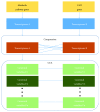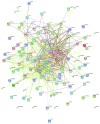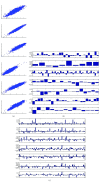Metabolic Pathway Genes Associated with Susceptibility Genes to Coronary Artery Disease
- PMID: 29607312
- PMCID: PMC5828413
- DOI: 10.1155/2018/9025841
Metabolic Pathway Genes Associated with Susceptibility Genes to Coronary Artery Disease
Abstract
Coronary artery disease (CAD) is one of the leading threats to global health. Previous research has proven that metabolic pathway disorders, such as high blood lipids and diabetes, are one of the risk factors that mostly cause CAD. However, the crosstalk between metabolic pathways and CAD was mostly studied on physiology processes by analyzing a single gene function. A canonical correlation analysis was used to identify the metabolic pathways, which were integrated as a unit to coexpress with CAD susceptibility genes, and to resolve additional metabolic factors that are related to CAD. Seven pathways, including citrate cycle, ubiquinone, terpenoid quinone biosynthesis, and N-glycan biosynthesis, were identified as an integrated unit coexpressed with CAD genes. These pathways could not be revealed as a coexpressed pathway through traditional methods as each single gene has weak correlation. Furthermore, sets of genes in these pathways were candidate markers for diagnosis and detection from patients' serum.
Figures





Similar articles
-
Peripheral-blood gene expression profiling studies for coronary artery disease and its severity in Xinjiang population in China.Lipids Health Dis. 2018 Jul 18;17(1):154. doi: 10.1186/s12944-018-0798-1. Lipids Health Dis. 2018. PMID: 30021655 Free PMC article.
-
Integrative genomic analysis identified common regulatory networks underlying the correlation between coronary artery disease and plasma lipid levels.BMC Cardiovasc Disord. 2019 Dec 23;19(1):310. doi: 10.1186/s12872-019-01271-9. BMC Cardiovasc Disord. 2019. PMID: 31870308 Free PMC article.
-
Effects of Resveratrol on Crosstalk between Canonical Β-Catenin/Wnt and FOXO Pathways in Coronary Artery Disease Patients with Metabolic Syndrome: A Case Control Study.Iran J Pharm Res. 2016 Summer;15(3):547-559. Iran J Pharm Res. 2016. PMID: 27980591 Free PMC article.
-
Rationale and design of the LURIC study--a resource for functional genomics, pharmacogenomics and long-term prognosis of cardiovascular disease.Pharmacogenomics. 2001 Feb;2(1 Suppl 1):S1-73. doi: 10.1517/14622416.2.1.S1. Pharmacogenomics. 2001. PMID: 11258203 Review.
-
Coronary artery disease: Are men and women created equal?Gend Med. 2009 Sep;6(3):410-8. doi: 10.1016/j.genm.2009.09.005. Gend Med. 2009. PMID: 19850237 Review.
Cited by
-
NCF2, MYO1F, S1PR4, and FCN1 as potential noninvasive diagnostic biomarkers in patients with obstructive coronary artery: A weighted gene co-expression network analysis.J Cell Biochem. 2019 Oct;120(10):18219-18235. doi: 10.1002/jcb.29128. Epub 2019 Jun 27. J Cell Biochem. 2019. PMID: 31245869 Free PMC article.
-
Interaction between CETP Taq1B polymorphism and dietary patterns on lipid profile and severity of coronary arteries stenosis in patients under coronary angiography: a cross-sectional study.Nutr J. 2023 Dec 14;22(1):70. doi: 10.1186/s12937-023-00899-w. Nutr J. 2023. PMID: 38098040 Free PMC article.
-
Genetic Polymorphism of Angiotensin II Type 1 Receptors and Their Effect on the Clinical Outcome of Captopril Treatment in Arab Iraqi Patients with Acute Coronary Syndrome (Mid Euphrates).Indian J Clin Biochem. 2021 Jan;36(1):81-87. doi: 10.1007/s12291-019-00860-x. Epub 2019 Dec 2. Indian J Clin Biochem. 2021. PMID: 33505131 Free PMC article.
-
Dietary antioxidant status indices may not interact with CETP Taq1B polymorphism on lipid profile and severity of coronary artery stenosis in patients under coronary angiography.Food Sci Nutr. 2023 Nov 28;12(2):1012-1022. doi: 10.1002/fsn3.3815. eCollection 2024 Feb. Food Sci Nutr. 2023. PMID: 38370072 Free PMC article.
-
Bioinformatics Analysis to Find Novel Biomarkers for Coronary Heart Disease.Iran J Public Health. 2022 May;51(5):1152-1160. doi: 10.18502/ijph.v51i5.9430. Iran J Public Health. 2022. PMID: 36407720 Free PMC article.
References
-
- Calderon R., Jr., Schneider R. H., Alexander C. N., Myers H. F., Nidich S. I., Haney C. Stress, stress reduction and hypercholesterolemia in African Americans: a review. Ethnicity & disease. 1998;9(3):451–462. - PubMed
LinkOut - more resources
Full Text Sources
Other Literature Sources
Miscellaneous

